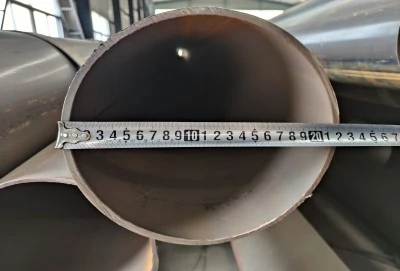Hebei Longma Group Limited (LONGMA GROUP), a leading manufacturer of ERW and LSAW steel pipes since 2003, has been at the forefront of this industry, witnessing firsthand the growing demand and evolving applications of ERW steel pipes. With our extensive experience and state-of-the-art production facilities, we're well-positioned to explore why ERW steel pipes are increasingly becoming the go-to choice for savvy investors and industry professionals alike.
|
|
|
Cost-Effective Solutions with ERW Steel Pipe
When it comes to large-scale projects, cost-effectiveness is paramount. ERW steel pipes shine in this aspect, offering a myriad of financial benefits that make them an attractive option for investors and project managers.
The manufacturing process of ERW steel pipes is inherently efficient. The electric resistance welding technique allows for continuous production, resulting in higher output rates compared to other welding methods. This efficiency translates directly into cost savings, as production times are reduced and material waste is minimized.
Moreover, the raw materials used in ERW steel pipe production are typically less expensive than those required for seamless pipes. The steel strip or coil used as the base material is more readily available and can be sourced at competitive prices, further contributing to the overall cost-effectiveness of ERW pipes.
The lightweight nature of ERW steel pipes also plays a crucial role in their economic appeal. Compared to seamless pipes of similar strength, ERW pipes are often lighter, which leads to significant savings in transportation and installation costs. This weight advantage becomes particularly pronounced in large-scale projects where hundreds or thousands of pipes may be required.
Another factor that contributes to the cost-effectiveness of ERW steel pipes is their longevity. When properly manufactured and installed, these pipes boast impressive durability and resistance to corrosion. This translates into lower maintenance costs over the lifetime of the pipe, reducing the total cost of ownership for investors.
The versatility of ERW steel pipes also adds to their economic value. They can be used in a wide range of applications, from water and gas distribution to structural support in buildings and bridges. This adaptability means that companies can streamline their inventory, potentially reducing storage costs and simplifying procurement processes.
Furthermore, the consistency in quality achieved through the ERW process means fewer rejected pipes and less wastage. The automated nature of ERW manufacturing ensures a high degree of uniformity in wall thickness and weld quality, reducing the likelihood of defects that could lead to costly replacements or repairs down the line.
Lastly, the energy efficiency of the ERW process itself contributes to cost savings. The localized heating required for welding consumes less energy compared to other pipe manufacturing methods, which can lead to lower production costs and a smaller carbon footprint—an increasingly important consideration in today's environmentally conscious market.
How ERW Steel Pipe Improves Efficiency in Manufacturing
The impact of ERW steel pipes on manufacturing efficiency is profound and multifaceted. From the production floor to the end-user application, these pipes contribute to streamlined processes and improved overall productivity.
One of the primary ways ERW steel pipes enhance manufacturing efficiency is through their rapid production capabilities. The ERW process allows for high-speed welding, with some modern production lines capable of producing pipes at rates of up to 100 meters per minute. This speed is unmatched by other pipe manufacturing methods, enabling manufacturers to meet tight deadlines and respond quickly to market demands.
The precision of the ERW process also contributes significantly to manufacturing efficiency. Advanced controls and monitoring systems ensure that the welding process is consistently accurate, resulting in pipes with uniform properties along their entire length. This consistency reduces the need for extensive quality control checks and minimizes the risk of defects that could slow down production or lead to costly rework.
ERW steel pipes also offer excellent dimensional accuracy. The tight tolerances achievable with ERW manufacturing mean that pipes can be produced to exact specifications, reducing the need for on-site adjustments during installation. This precision translates into time savings and reduced labor costs for end-users, further enhancing the overall efficiency of projects that utilize these pipes.
The versatility of ERW steel pipes in terms of size ranges is another efficiency booster. Manufacturers can produce pipes with a wide range of diameters and wall thicknesses on the same production line with minimal setup changes. This flexibility allows for efficient batch production and quick changeovers, enabling manufacturers to respond swiftly to varied customer requirements without significant downtime.
In the context of supply chain management, ERW steel pipes offer advantages that contribute to overall manufacturing efficiency. Their standardized production process and widespread availability mean that they can be sourced from multiple suppliers, reducing the risk of supply chain disruptions. This reliability is crucial for maintaining efficient production schedules in industries that depend on a steady supply of piping materials.
The lightweight nature of ERW steel pipes, as mentioned earlier, also plays a role in improving efficiency beyond just cost savings. Lighter pipes are easier to handle and install, reducing labor requirements and speeding up construction processes. This can be particularly beneficial in large-scale projects where time is of the essence.
Additionally, the smooth interior surface of ERW steel pipes contributes to operational efficiency in fluid transport applications. The reduced friction allows for more efficient flow, which can lead to energy savings in pumping systems and improved overall system performance.
The efficiency gains extend to the finishing processes as well. ERW steel pipes are well-suited for various coating and lining applications, which can be applied more uniformly and efficiently compared to pipes with irregular surfaces. This compatibility with secondary processing enhances the pipes' versatility and allows for efficient customization to meet specific project requirements.
Lastly, the efficiency of ERW steel pipe manufacturing has a ripple effect on related industries. The consistent quality and availability of these pipes enable more efficient planning and execution of projects in sectors such as construction, oil and gas, and water management. This reliability contributes to smoother project timelines and reduced bottlenecks, enhancing overall industry efficiency.
The Future of Electric Resistance Welded Steel Pipes
As we look towards the horizon of industrial development, the future of Electric Resistance Welded steel pipes appears both promising and transformative. The ongoing evolution of ERW technology, coupled with emerging market trends and environmental considerations, is set to further cement the position of ERW steel pipes as a smart investment for years to come.
One of the most exciting prospects for the future of ERW steel pipes lies in the realm of advanced materials. Research and development efforts are focused on creating high-strength, low-alloy steels that can be effectively welded using the ERW process. These new materials promise to expand the application range of ERW pipes, potentially allowing them to replace more expensive alternatives in high-pressure and high-temperature environments.
The integration of smart technologies into the ERW manufacturing process is another area poised for significant advancement. Industry 4.0 principles are being applied to ERW production lines, incorporating sensors, real-time data analytics, and machine learning algorithms to further enhance quality control and production efficiency. These smart factories will be capable of producing ERW steel pipes with even greater precision and consistency, while also optimizing energy use and reducing waste.
For those looking to stay at the forefront of these developments and leverage the benefits of ERW steel pipes in their projects, partnering with an experienced and innovative manufacturer is key. Hebei Longma Group Limited (LONGMA GROUP) remains committed to pushing the boundaries of ERW technology and providing high-quality, cost-effective solutions to meet the evolving needs of our clients.
To learn more about how ERW steel pipes can benefit your next project or to discuss custom solutions, please don't hesitate to contact us. Our team of experts is ready to help you make a smart investment in the future of your business.














